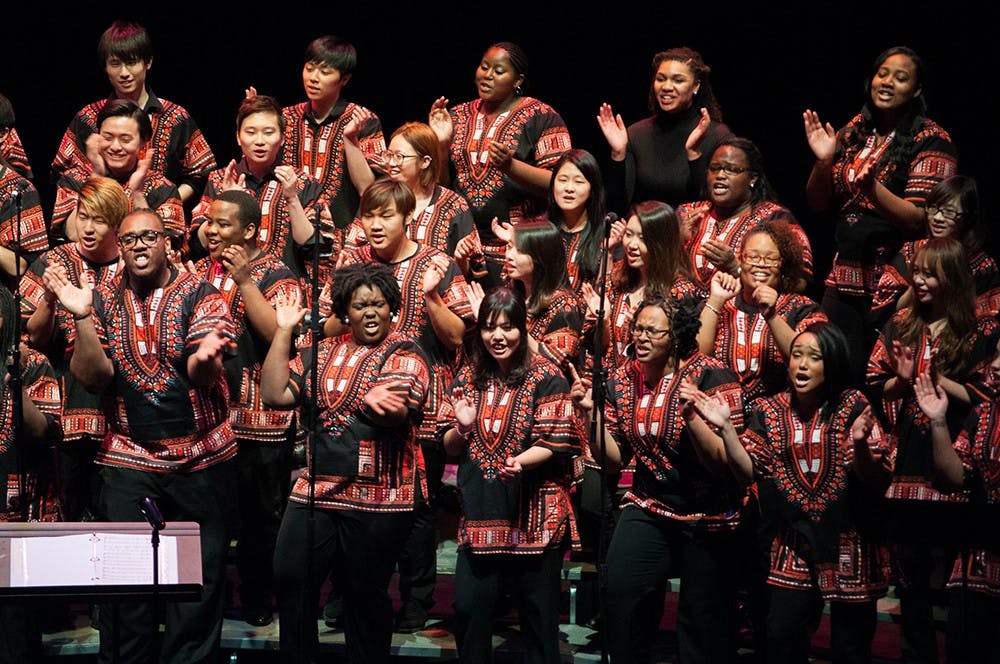As the African American Choral Ensemble prepared during the week of their upcoming concert, ensemble members clapped while they swayed side-to-side, bobbed their heads and even spontaneously busted a dance move as they sang. Satsu Holmes, an alto in the ensemble, initially joined AACE last semester in order to earn dual credit for her music minor. Although she didn’t have any previous ensemble experience, she said she was glad she decided to join.
“I didn’t sing in church or any kind of vocal ensemble experience whatsoever, and I was just completely welcomed into the fold,” Holmes said. “I made friends with the people in my section, and the choir is a family. It really is.”
At 8 p.m. Saturday at the ?Buskirk-Chumley Theater, Holmes, alongside her fellow ensemble members, will perform in the final AACE concert of the school year.
The AACE is a course and one of three performing ensembles in the African American Arts Institute. The ensemble’s traditional repertoire includes choral anthems, hymns, spirituals, inspirational, gospel and formally composed works for and by African-Americans, according to the concert’s program notes.
Raymond Wise, director of the AACE and professor of practice in the Department of African American and African Diaspora Studies, said the concert will follow their traditional repertoire.
The concert will open with the processional piece “Sorida,” a traditional Zimbabwe greeting song, followed by a set of spirituals. Then, formally composed works by African-Americans will follow.
Next will be an audience participation section that will include call-and-response involvement from the ensemble and audience members. Wise said the traditional European aesthetic has more audience involvement. He said repetition and imrovisation are important because as you continually repeat something, the audience gets to pick it up and learn it so they can sing along.
“The energy and excitement of not knowing what’s happening creates this kind of excitement and anticipation of what will happen today,” Wise said.
Next, a selection of inspirational songs titled “We Remember” will be performed to honor individuals and important events of the past.
“We’re remembering the march on Selma, our friend and colleague Steve Zegree who just recently passed here and the ‘I have a Dream’ speech by Martin Luther King,” Wise said. “So we remember that legacy.”
The concert will come to a close with some gospel songs. Holmes said “The Best Days of Your Life” is one of the pieces she looks forward to singing most. She said there is a lot of repetition in the song, but it comes together in the simplicity of it.
“Dr. Wise will talk about repetition when you’re singing to an audience,” Holmes said. “It allows them to hear and rehear what you’re saying, and so the message becomes stronger.”
Originally from Hawaii, Holmes said she has enjoyed being a part of the AACE because she didn’t have a lot of exposure to African-American culture growing up.
“It’s been a beautiful learning experience for me because through the song you learn about the culture, and that’s one of the great things about this music,” Holmes said.
Holmes said she recommends people go to the concert because there is nothing like this ensemble available on campus, and the music they sing has the ability to speak to ?everyone.
“Music is such a vital part of our lives,” Holmes said. “This is an offering that shouldn’t be missed because we’re good. I think people will come in not expecting what they’ll get out of it, and that’s a good thing.”
Besides singing experience, Holmes said she has gained many friends within the ensemble. She said sitting in a classroom with students and not really taking the time to get to know them is a much different experience than producing something as personal as music in an ensemble.
“The person next to you is trying to do the exact same thing in time, on the same notes and you understand that you and your section are part of this larger ensemble,” Holmes said. “You and the ensemble are this one cohesive unit that’s trying to do something together.”






